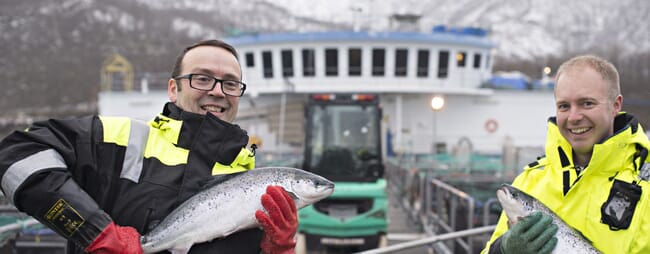The report, by Nofima, established that Chile was the now the most cost-efficient country for salmon production, while costs have been rising more substantially in Norway, the Faroe Islands, Scotland and Canada.

© Jon-Are Berg-Jacobsen, Nofima
“The driving forces behind the increase in cost are the same in all countries but are of different strengths. Chile has had a considerable improvement in biological results, clearly visible in costs. The Faroe Islands have lost some ground after experiencing larger challenges with lice and disease. Scotland and Canada have the highest costs, and while the increase has been moderate in Canada in recent years, it has been very large in Scotland,” said Nofima scientist Audun Iversen.
The research, published as “Competitiveness of Norwegian farmed salmon: Cost and cost drivers in competitor countries” was undertaken by Iversen on behalf of the Norwegian Seafood Research Fund (FHF). He was joined by his Nofima colleague Øystein Hermansen and the analysts Ragnar Nystøyl, Knut Henrik Rolland and Lars Daniel Garshol at Kontali Analyse.
Expenses related to smolt, feed, salaries, depreciation, taxes and duties and “other operating costs”, where much of the health and lice costs are found, vary widely from country to country.
While Norwegian producers have costs of NOK 37.85 per kilogram in 2018 (slaughtered and packed salmon, excluding interest), Chilean producers are now down to NOK 35.40. This is approximately 6.5 percent lower than in Norway. There is also a marked change from the previous analysis, with figures from 2015, when Chile had a production cost 1 NOK higher than Norway.
“Chile has experienced a considerable improvement in biological results, clearly seen in costs. A particularly positive effect has arisen from the work aimed at reducing disease (SRS),” says Hermansen.
The Faroe Islands had a level 2.5 percent above Norway, at NOK 38.8 per kilogram.
“The Faroe Islands’ cost position has been weakened and is now slightly above Norway in level of costs. They have gone from having the best biological results by far to being more on the same level as Norway. They have had challenges both with the transition to very large smolt and the implementation of new lice treatment methods. However, there is still a gap up to Canada and Scotland, which have the highest costs,” says Hermansen.
While the increase has been moderate in Canada in recent years, it has been very large in Scotland. Canada has costs of NOK 41.8 per kilogram (11 percent higher than Norway). Scotland had substantially higher costs than this, with NOK 48.2 per kilogram, or 28 percent above the Norwegian level.
Currently, it does not seem that Scotland and Canada could threaten Norway’s competitive position.
“In Canada, we also see a modernisation of the industry, and there is still considerable potential for growth, especially on the east coast,” says Iversen. Scotland has a few biological challenges, including gill problems. In addition, there was a decline in production in 2018. This means that the fixed costs have greater significance.
The two industrial economics researchers at Nofima conclude that there are complex explanations for the differences in costs between the five producer countries.
“Higher costs are caused by slightly less favourable natural conditions, higher mortality rates, more disease, less scale and less advanced technology. Norway still has among the best natural conditions, good infrastructure, large facilities, efficient technology and a well-developed service industry. This means that Norwegian producers are competitive, even with a high Norwegian level of costs,” says Iversen.
Trends and driving forces
Many major trends and driving forces affect the aquaculture industry, and therefore also the industry’s cost development. These development trends also apply in our competitor countries, but scientists believe we must expect it to happen in varying degrees:
- Technology is constantly evolving. Investments are being made in more solid equipment, on a larger scale and in more advanced equipment for monitoring, automation and streamlining.
- Climatic and ecological factors, such as temperature, current and depth, can produce rather large differences in production.
- Biological factors are important for production outcomes, and both growth and survival, disease and parasites vary considerably between countries.
- Market conditions change, because of the change in attitudes and consumer preferences, currency, trade policies and so on.
- Markets for production factors, such as smolt, feed, equipment and so on are constantly changing, and are developed to varying degrees in the different competitor countries.
- Regulatory requirements, including the environment, fish welfare, HSE and so on, have both operational and administrative consequences.
- Concessions and regulations, particularly measures that limit production, affect costs while determining the frameworks for future growth.
“This type of information is important in order to assess how the Norwegian growth of costs affects the competitive relationship with our competitors, and it is information that will shed light on the conditions for the future growth and development of the industry,” concludes Iversen.




